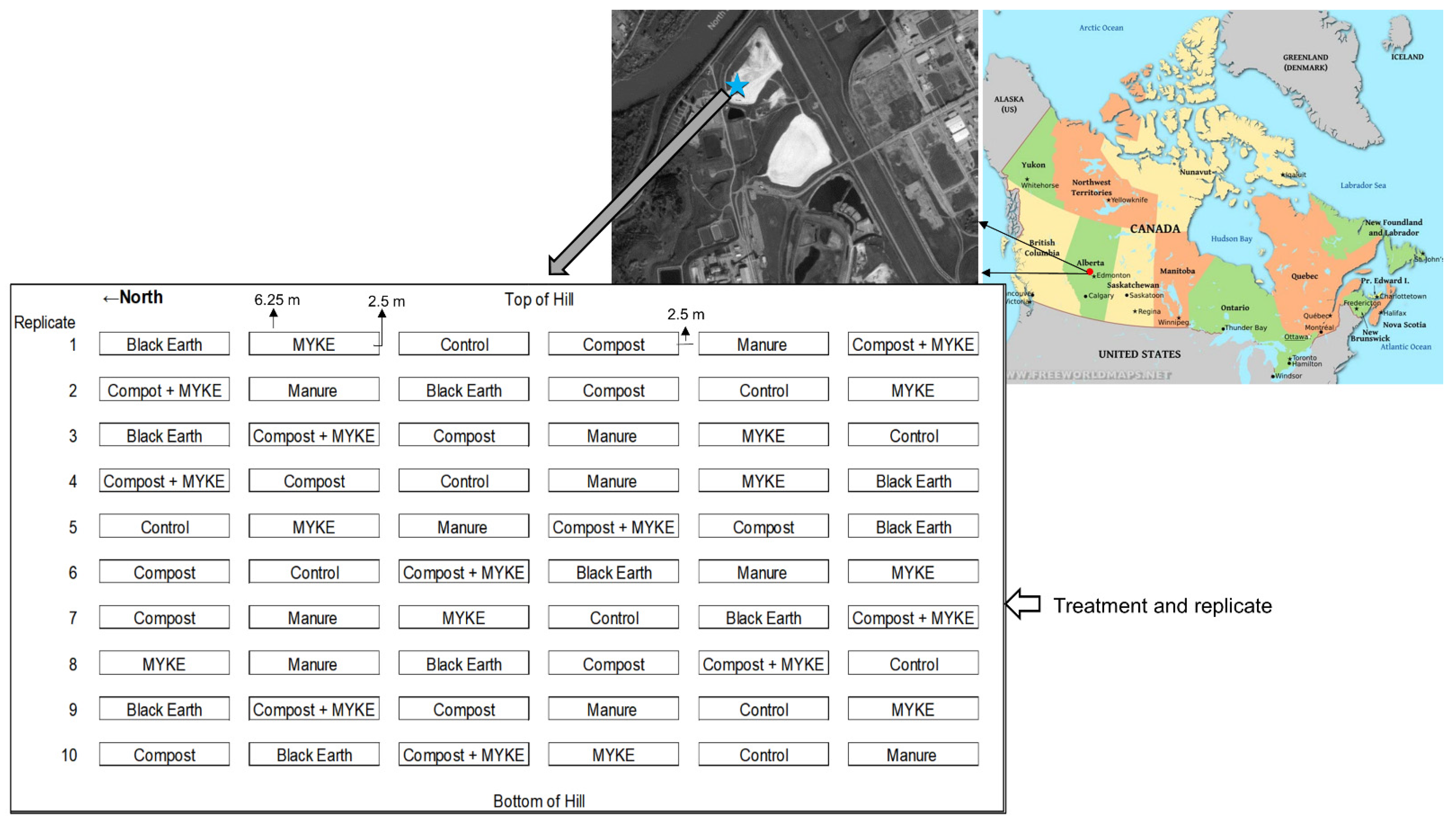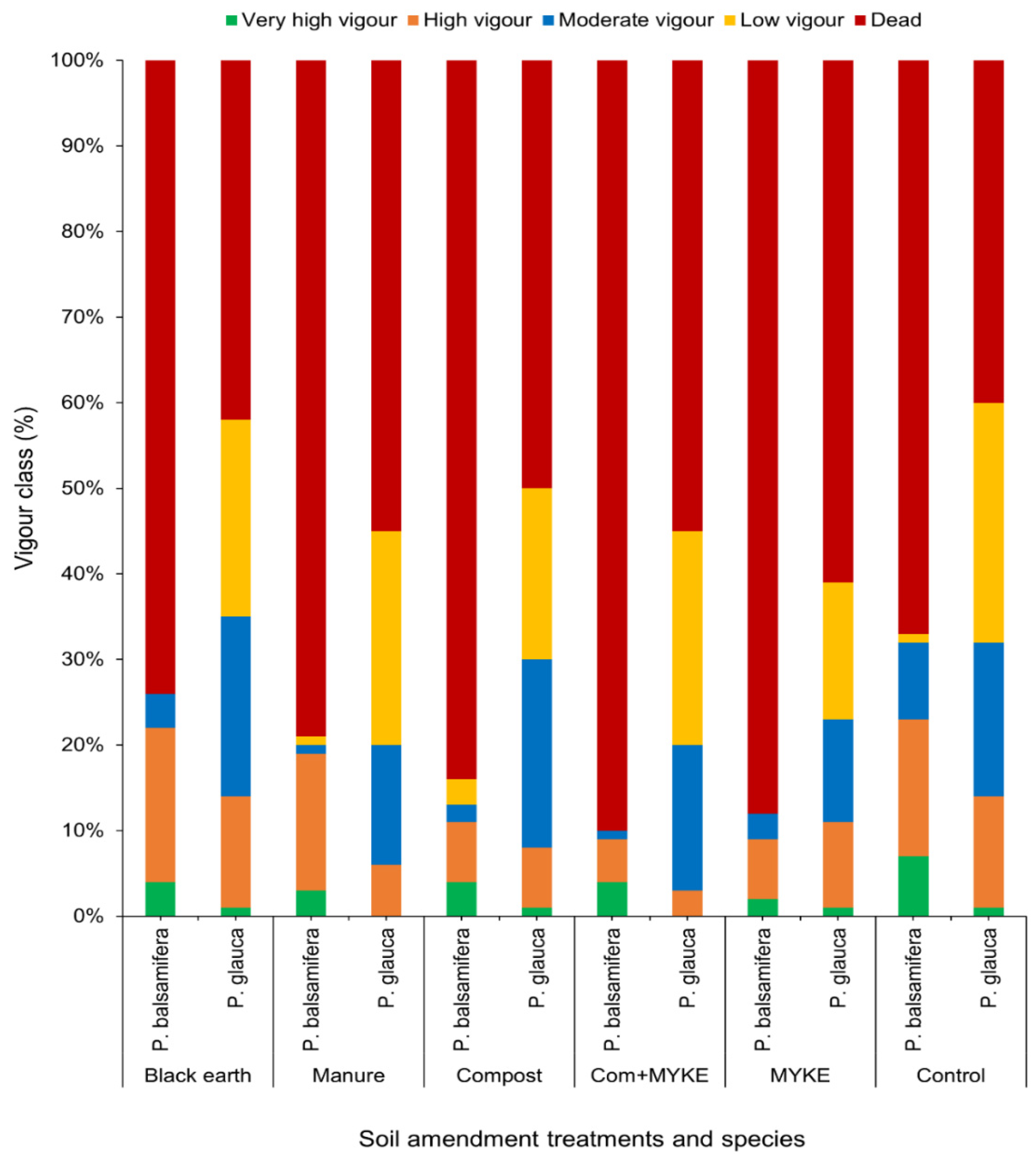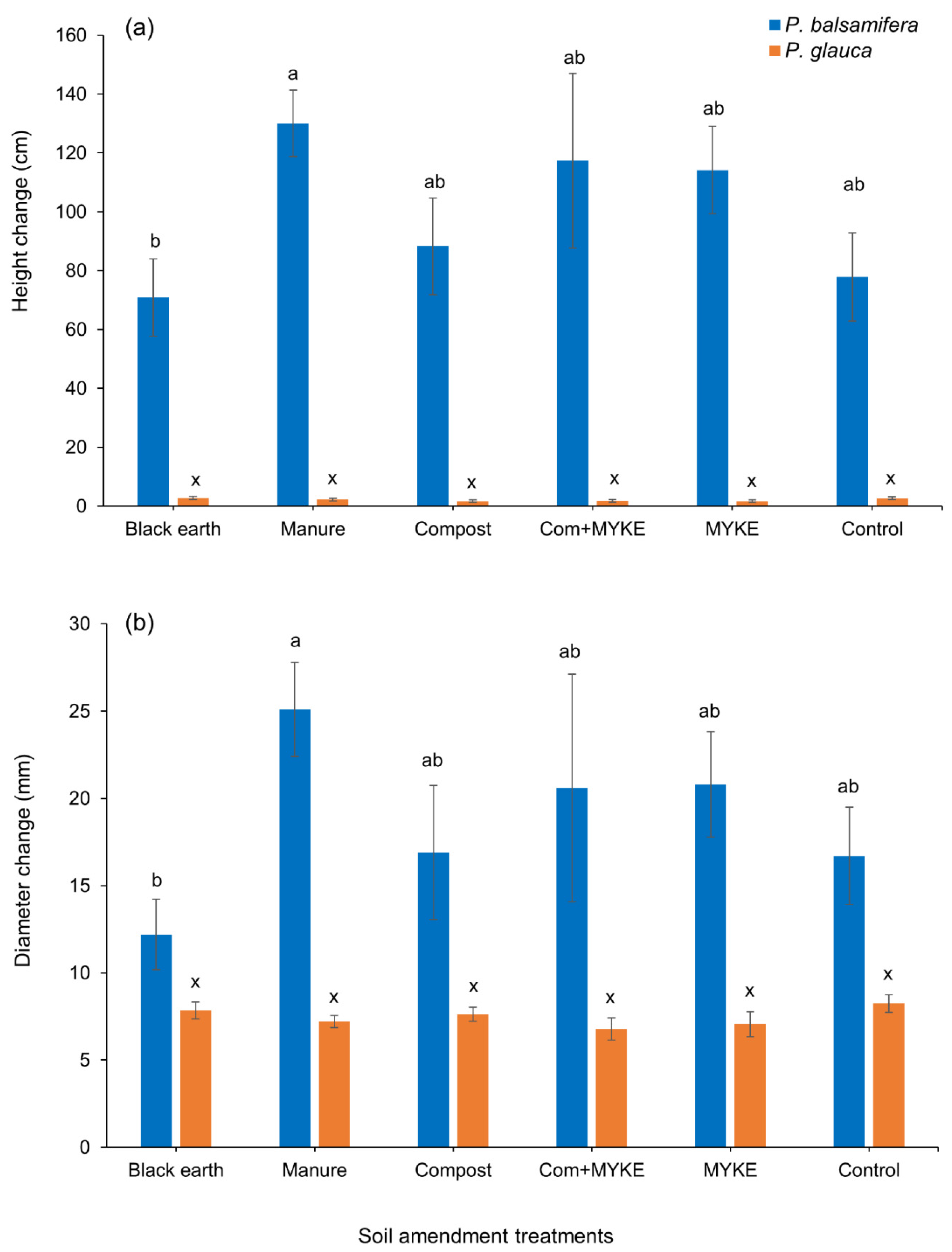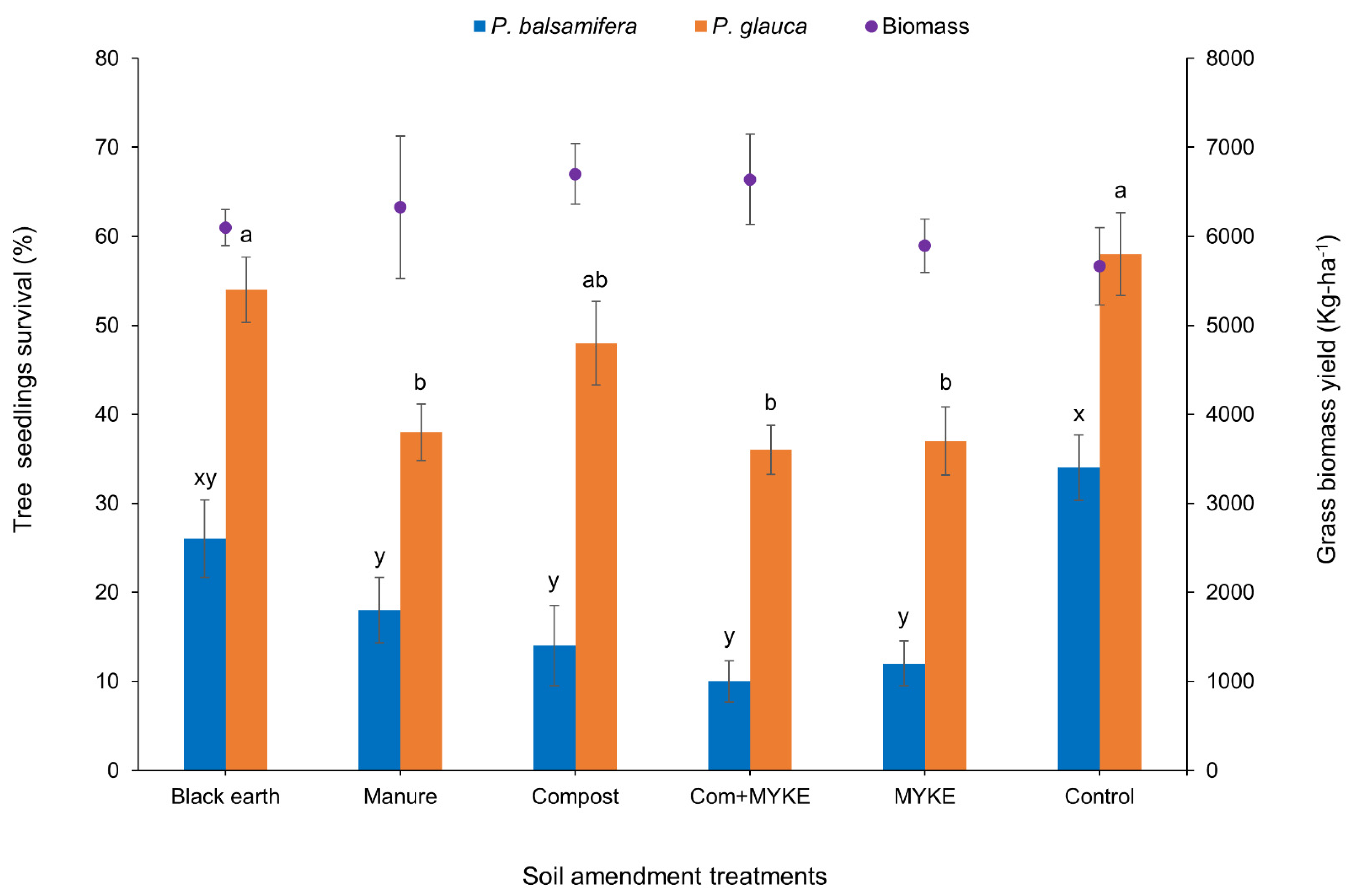Phosphogypsum Stack Reclamation Using Soil Amendments and Short-Rotational Woody Species
Abstract
1. Introduction
2. Materials and Methods
2.1. Study Location
2.2. Experimental Design and Treatments
2.3. Soil Analyses
2.4. Plant Stock and Management
2.5. Vegetation Assessment
2.6. Statistical Analyses
3. Results
3.1. Effect of Amendments on Planted Species
3.2. Effect of Competing Vegetation on Planted Species
3.3. Effect of Amendments on Soil Parameters
4. Discussion
5. Conclusions
Author Contributions
Funding
Data Availability Statement
Acknowledgments
Conflicts of Interest
References
- Tayibi, H.; Choura, M.; Lopez, F.A.; Alguacil, F.J.; Lopez-Delgado, A. Environmental impact and management of phosphogypsum. J. Environ. Manag. 2009, 90, 2377–2386. [Google Scholar] [CrossRef] [PubMed]
- Saadaoui, E.; Ghazel, N.; Romdhane, C.B.; Massoudi, N. Phosphogypsum: Potential uses and problems. Int. J. Environ. Stud. 2017, 74, 558–567. [Google Scholar] [CrossRef]
- Bituh, T.; Petrinec, B.; Skoko, B.; Babić, D.; Rašeta, D. Phosphogypsum and its potential use in Croatia: Challenges and opportunities. Arh. Hig. Rada. Toksikol. 2021, 72, 93–100. [Google Scholar] [CrossRef]
- Turner, L.E.; Dhar, A.; Naeth, M.A.; Chanasyk, D.S.; Nichol, C.K. Effect of soil capping depth on phosphogypsum stack revegetation. Environ. Sci. Pollut. Res. 2022, 29, 50166–50176. [Google Scholar] [CrossRef] [PubMed]
- Rutherford, P.M.; Dudas, M.J.; Samek, R.A. Environmental impacts of phosphogypsum. Sci. Total Environ. 1994, 149, 1–38. [Google Scholar] [CrossRef]
- Yang, J.; Liu, W.; Zhang, L.; Xiao, B. Preparation of load-bearing building material from autoclaved phosphogypsum. Constr. Build. Mater. 2009, 23, 687–693. [Google Scholar] [CrossRef]
- Chernysh, Y.; Yakhnenko, O.; Chubur, V.; Roubík, H. Phosphogypsum recycling: A review of environmental issues, current trends, and prospects. Appl. Sci. 2021, 11, 1575. [Google Scholar] [CrossRef]
- Patel, S.K.; Ericson, W.A.; Kelley, M.P. Phosphogypsum Stack Closure: Evaluation of Phosphogypsum as an Alternative Final Cover; BCI Engineers and Scientists Inc.: Lakeland, FL, USA, 2002; p. 122. [Google Scholar]
- Boldt-Burisch, K.; Naeth, M.A. Phosphogypsum significantly alters root growth and fungal colonization of smooth brome and sheep fescue on a reclamation site. Rhizosphere 2019, 9, 106–109. [Google Scholar] [CrossRef]
- Hallin, I.L.; Naeth, M.A.; Chanasyk, D.S.; Nichol, C.K. Assessment of a reclamation cover system for phosphogypsum stacks in Central Alberta. J. Environ. Qual. 2010, 39, 2160–2169. [Google Scholar] [CrossRef]
- Jackson, M.; Naeth, M.A.; Chanasyk, D.S.; Nichol, C.K. Phosphogypsum capping depth affects revegetation and hydrology in western Canada. J. Environ. Qual. 2010, 40, 1122–1129. [Google Scholar] [CrossRef]
- Parrotta, J.A.; Turnbull, J.W.; Jones, N. Catalyzing native forest regeneration on degraded tropical lands. For. Ecol. Manag. 1997, 99, 1–7. [Google Scholar] [CrossRef]
- Guariguata, M.R.; Rheingans, R.; Montagnini, F. Early woody invasion under tree plantations in Costa Rica: Implications for forest restoration. Restor. Ecol. 1995, 3, 252–260. [Google Scholar] [CrossRef]
- Parrotta, J.A. Influence of overstory composition on understory colonization by native species in plantations on a degraded tropical site. J. Veg. Sci. 1995, 6, 627–636. [Google Scholar] [CrossRef]
- Carnevale, N.J.; Montagnini, F. Facilitating regeneration of secondary forests with the use of mixed and pure plantations of indigenous tree species. For. Ecol. Manag. 2002, 163, 217–227. [Google Scholar] [CrossRef]
- Boothroyd-Roberts, K.; Gagnon, D.; Truax, B. Can hybrid poplar plantations accelerate the restoration of forest understory attributes on abandoned fields? For. Ecol. Manag. 2013, 287, 77–89. [Google Scholar] [CrossRef]
- Bouchard, H.; Guittonny, M.J.; Brais, S. Early recruitment of boreal forest trees in hybrid poplar plantations of different densities on mine waste rock slopes. For. Ecol. Manag. 2018, 429, 520–533. [Google Scholar] [CrossRef]
- Laureysens, I.; Bogaert, J.; Blust, R.; Ceulemans, R. Biomass production of 17 poplar clones in a short-rotation coppice culture on a waste disposal site and its relation to soil characteristics. For. Ecol. Manag. 2004, 187, 295–309. [Google Scholar] [CrossRef]
- Rockwood, D.L.; Cardellino, R.; Alker, G.; Lin, C.; Brown, N.; Spriggs, T.; Tsangaris, S.; Isebrands, J.; Hall, R.; Lange, R.; et al. Fast-growing trees for heavy metal and chlorinated solvent phytoremediation. In Proceedings of the Seventh International In Situ and On-Site Bioremediation Symposium, Orlando, FL, USA, 2–5 June 2003; Battelle Press: Columbus, OH, USA; p. F-12. [Google Scholar]
- Langholtz, M.; Carter, D.R.; Rockwood, D.L.; Alavalapati, J.R.R. The economic feasibility of reclaiming phosphate mined lands with short-rotation woody crops in Florida. J. For. Econ. 2007, 12, 237–249. [Google Scholar] [CrossRef]
- Rockwood, D.L.; Naidu1, C.V.; Carter, D.R.; Rahmani, M.; Spriggs, T.A.; Lin, C.; Alker, G.R.; Isebrands, J.G.; Segrest, S.A. Short-rotation woody crops and phytoremediation: Opportunities for agroforestry? Agrofor. Syst. 2004, 61, 51–63. [Google Scholar]
- Lugo, A.E. The apparent paradox of reestablishing species richness on degraded lands with tree monocultures. For. Ecol. Manag. 1997, 99, 9–19. [Google Scholar] [CrossRef]
- Otsamo, R. Secondary forest regeneration under fast-growing forest plantations on degraded Imperata cylindrica grasslands. New For. 2000, 19, 69–93. [Google Scholar] [CrossRef]
- Powers, J.S.; Haggar, J.P.; Fisher, R.F. The effect of overstory composition on understory woody regeneration and species richness in 7-year-old plantations in Costa Rica. For. Ecol. Manag. 1997, 99, 43–54. [Google Scholar] [CrossRef]
- Filcheva, E.; Noustorova, M.; Gentcheva-Kostadinova, S.; Haigh, M. Organic accumulation and microbial action in surface coal-mine spoils, Pernik, Bulgaria. Ecol. Eng. 2000, 15, 1–15. [Google Scholar] [CrossRef]
- Wilkinson, A. Poplars and willows for soil erosion control in New Zealand. Biomass Bioenergy 1999, 16, 263–274. [Google Scholar] [CrossRef]
- Douglas, G.B.; McIvor, I.R.; Potter, J.F.; Foote, L.G. Root distribution of poplar at varying densities on pastoral hill country. Plant Soil 2010, 333, 147–161. [Google Scholar] [CrossRef]
- Espigares, T.; Moreno-de las Heras, M.; Nicolau, J.M. Performance of vegetation in reclaimed slopes affected by soil erosion. Restor. Ecol. 2011, 19, 35–44. [Google Scholar] [CrossRef]
- Samson, R.; Girouard, P.; Zan, C.; Mehidi, B.; Martin, R.; Henning, J. The Implications of Growing Short Rotation Trees Species for Carbon Sequestration in Canada. Final Report. National Climate Change Process, Solicitation no. 23103-8-0253/N. 1999, p. 91. Available online: https://www.reap-canada.com/online_library/ghg_offsets_policy/20%20The%20Implications.pdf (accessed on 9 August 2022).
- Alberta Environment. Operating Approval under the Environmental Protection and Enhancement Act; Approval No. 20477-01-00; Agrium Products Inc.: Fort Saskatchewan, AB, Canada; Government of Alberta: Edmonton, AB, Canada, 2008; p. 27. [Google Scholar]
- Government of Alberta. Environmental Protection and Enhancement Act (EPEA). Revised Statutes of Alberta 2000 Chapter E-12. 2019. Available online: https://www.qp.alberta.ca/documents/Acts/E12.Pdf (accessed on 8 August 2022).
- Dhar, A.; Comeau, P.G.; Karst, J.; Pinno, B.D.; Chang, S.X.; Naeth, A.M.; Vassov, R.; Bampfylde, C. Plant community development following reclamation of oil sands mine sites in the boreal forest: A review. Environ. Rev. 2018, 26, 286–298. [Google Scholar] [CrossRef]
- Shiralipour, A.; McConnell, D.B.; Smith, W.H. Physical and chemical properties of soils as affected by municipal waste compost application. Biomass Bioenergy 1992, 3, 261–266. [Google Scholar] [CrossRef]
- Moore, P.A.; Daniel, T.C.; Sharpley, A.N.; Wood, C.W. Poultry manure management: Environmentally sound options. J. Soil Water Conserv. 1995, 50, 321–327. [Google Scholar]
- Black Earth. Mini-Granule Coarse: Product Brochure. Ryley Alberta. 2014, p. 4. Available online: http://www.hortimax.biz/BlackEarth/BlackEarth-MiniGranule_Coarse.pdf (accessed on 12 July 2022).
- Bonfante, P.; Anca, I.A. Plants, mycorrhizal fungi, and bacteria: A network of interactions. Annu. Rev. Microbiol. 2009, 63, 363–383. [Google Scholar] [CrossRef]
- Asmelash, F.; Bekele, T.; Birhane, E. The potential role of arbuscular mycorrhizal fungi in the restoration of degraded lands. Front. Microbiol. 2016, 7, 1095. [Google Scholar] [CrossRef] [PubMed]
- Wang, F. Occurrence of arbuscular mycorrhizal fungi in mining-impacted sites and their contribution to ecological restoration: Mechanisms and applications. Crit. Rev. Environ. Sci. Technol. 2017, 47, 1901–1957. [Google Scholar] [CrossRef]
- Parsons, R.F. Gypsophily in plants. A review. Am. Midl. Nat. 1976, 96, 1–20. [Google Scholar] [CrossRef]
- Guerrero-Campo, J.; Alberto, F.; Maestro Martınez, M.; Hodgson, J.; Montserrat Martı, G. Plant community patterns in a gypsum area of NE Spain. II. Effects of ionwashing on topographic distribution of vegetation. J. Arid Environ. 1999, 41, 411–419. [Google Scholar] [CrossRef]
- Khabou, W.; Hajji, B.; Zouari, M.; Rigane, H.; Abdallah, F.B. Arbuscular mycorrhizal fungi improve growth and mineral uptake of olive tree under gypsum substrate. Ecol. Eng. 2014, 73, 290–296. [Google Scholar] [CrossRef]
- Linderman, R.G.; Call, C.A. Enhanced rooting of woody plant cuttings by mycorrhizal fungi. J. Am. Soc. Hortic. Sci. 1977, 102, 629–632. [Google Scholar] [CrossRef]
- Prysedskyi, Y.; Mashtaler, M. Growth parameters of herbaceous plants on phosphogypsum dumps with using soil coverings based on sewage sludge. J. Ecol. Eng. 2021, 22, 20–26. [Google Scholar] [CrossRef]
- Environment Canada. Canadian Climate Normals 1981–2010 Station Data. 2022. Available online: http://climate.weather.gc.ca/climate_normals/results_1981_2010_e.html?searchType=stnName&txtStationName=Fort+McMurray&searchMethod=contains&txtCentralLatMin=0&txtCentralLatSec=0&txtCentralLongMin=0&txtCentraLongSec=0&stnID=2519&dispBack=1 (accessed on 12 July 2022).
- Government of Canada. Canadian Biomass Innovation Network. Natural Resources Canada. 2015. Available online: http://www.nrcan.gc.ca/energy/renewable-electricity/bioenergy-systems/17160 (accessed on 26 October 2022).
- Keddy, T.; (Canadian Wood Fibre Center). Personal communication, 2017.
- Sparks, A.L.; Helmke, P.A.; Loeppert, R.H. Methods of Soil Analysis. Part 3—Chemical Methods; Soil Science Society of America, American Society of Agronomy: Madison, WI, USA, 1996, 1996; pp. 961–1010. [Google Scholar]
- McKeague, J.A. Manual on Soil Sampling and Methods Analysis; Canadian Society of Soil Science: Ottawa, ON, Canada, 1981; p. 212. [Google Scholar]
- Ashworth, J.; Mrazek, K. Modified kelowna test for available phosphorus and potassium in soil. Commun. Soil Sci. Plant Anal. 1995, 26, 731–739. [Google Scholar] [CrossRef]
- Carter, M.R.; Gregorich, E.G. Soil Sampling and Methods of Analysis, 2nd ed.; Taylor & Francis Group: Boca Raton, FL, USA, 2008; p. 1264. [Google Scholar]
- R Core Team. R: A Language and Environment for Statistical Computing. R Foundation 110 for Statistical Computing; 2021; Vienna, Austria; Available online: http://www.R-project.org/ (accessed on 1 August 2021).
- Fortier, J.; Gangon, D.; Truax, B.; Lambert, F. Biomass and volume yield after 6 years in multiclonal hybrid poplar riparian buffer strips. Biomass Bioenergy 2010, 34, 1028–1040. [Google Scholar] [CrossRef]
- Miller, V.S.; Naeth, M.A. Amendments and substrates to develop Anthroposols for northern mine reclamation. Can. J. Soil Sci. 2017, 97, 266–277. [Google Scholar] [CrossRef]
- Messier, C.; Parent, S.; Bergeron, Y. Effects of overstory and understory vegetation on the understory light environment in mixed boreal forests. J. Veg. Sci. 1998, 9, 511–520. [Google Scholar] [CrossRef]
- Lieffers, V.J.; Messier, C.; Stadt, K.J.; Gendron, F.; Comeau, P. 1999. Predicting and managing light in the understory of boreal forests. Can. J. For. Res. 1999, 29, 796–811. [Google Scholar] [CrossRef]
- Henkel-Johnson, D.; Macdonald, S.E.; Bork, E.W.; Thomas, B.R. Influence of weed composition, abundance, and spatial proximity on growth in young hybrid poplar plantations. For. Ecol. Manag. 2016, 362, 55–68. [Google Scholar] [CrossRef]
- Landhausser, S.M.; Lieffers, V.J. Growth of Populus tremuloides in association with Calamagrostis canadensis. Can. J. For. Res. 1998, 28, 396–401. [Google Scholar] [CrossRef]
- Dhar, A.; Wang, R.J.; Hawkins, C.D.B. Interaction of Trembling Aspen and Lodgepole Pine in a Young Sub Boreal Mixedwood Stand in Central British Columbia. Open J. For. 2015, 5, 129–138. [Google Scholar] [CrossRef][Green Version]
- Lieffers, J.V.; Pinno, D.B.; Stadt, J.K. Light Dynamics and Free-to-Grow Standards in Aspen Dominated Mixedwood Forests. For. Chron. 2002, 78, 37–45. [Google Scholar] [CrossRef]
- Lieffers, V.J.; Stadt, K.J.; Feng, Z. Free-to-Grow Regeneration Standards Are Poorly Linked to Growth of Spruce in Boreal Mixedwoods. For. Chron. 2007, 83, 818–824. [Google Scholar] [CrossRef]
- Weil, R.R.; Brady, N.C. Elements of the Nature and Properties of Soil, 4th ed.; Pearson Education: Cranbury, NJ, USA, 2021; p. 768. [Google Scholar]
- Boldt-Burisch, K.; (Brandenburg University of Technology, Cottbus, Germany). Personal communication, 2022.
- Zalesny, R.S., Jr.; Stanturf, J.A.; Gardiner, E.S.; Perdue, J.H.; Young, T.M.; Coyle, D.R.; Headlee, W.L.; Bañuelos, G.S.; Hass, A. Ecosystem services of woody crop production systems. BioEnergy Res. 2016, 9, 465–491. [Google Scholar] [CrossRef]
- Baldantoni, D.; Cicatelli, A.; Bellion, A.; Castiglione, S. Different behaviours in phytoremediation capacity of two heavy metal tolerant poplar clones in relation to iron and other trace elements. J. Environ. Manag. 2014, 146, 94–99. [Google Scholar] [CrossRef]
- Laureysens, I.; Blust, R.; De Temmerman, L.; Lemmens, C.; Ceulemans, R. Clonal variation in heavy metal accumulation and biomass production in a poplar coppice culture: I. Seasonal variation in leaf, wood and bark concentrations. Environ. Pollut. 2004, 131, 485–494. [Google Scholar] [CrossRef]
- Rogers, E.R.; Zalesny, R.S., Jr.; Hallett, R.A.; Headlee, W.L.; Wiese, A.H. Relationships among Root–Shoot Ratio, Early Growth, and Health of Hybrid Poplar and Willow Clones Grown in Different Landfill Soils. Forests 2019, 10, 49. [Google Scholar] [CrossRef]
- Dutton, M.V.; Humphreys, P.N. Assessing the Potential of Short Rotation Coppice (Src) for Cleanup of Radionuclide contaminated Sites. Int. J. Phytoremedia. 2005, 7, 279–293. [Google Scholar] [CrossRef] [PubMed]





| Soil Parameter | Black Earth | Manure | Compost | Compost + MYKE | MYKE | Control |
|---|---|---|---|---|---|---|
| Nitrate (ugg−1) | 3.3 (1.5) b | 12 (4.4) ab | 19.7 (5.0) a | 18 (2.6) a | 3.3 (0.6) b | 3.3 (2.1) b |
| Phosphorus (ugg−1) | 40.7 (6.0) bc | 53.3 (6.1) ab | 61.3 (1.2) a | 64 (7.8) a | 35.7 (2.5) c | 36 (6.1) c |
| Potassium (ugg−1) | 88.3 (6.5) b | 216 (67.9) a | 128.3 (5.5) b | 128 (16.5) b | 87 (3.0) b | 85 (1.0) b |
| Ammonium (ugg−1) | 1 (0.9) | 0.4 (0.0) | 1.2 (0.6) | 2.9 (2.3) | 0.8 (0.6) | 0.7 (0.5) |
| C:N Ratio | 12.3 (0.1) ab | 12 (0.2) ab | 11.7 (0.0) b | 12 (0.1) ab | 12.5 (0.1) a | 12.3 (0.2) ab |
| Total nitrogen (%) | 0.2 (0.0) | 0.2 (0.0) | 0.2 (0.0) | 0.2 (0.0) | 0.2 (0.0) | 0.2 (0.0) |
| Organic matter (%) | 4 (0.4) | 4.1 (0.4) | 4.4 (0.2) | 4.4 (0.3) | 4.1 (0.3) | 4 (0.7) |
| Inorganic carbon (%) | 0.1 (0.0) | 0.1 (0.0) | 0.1 (0.0) | 1 (0.0) | 0.1 (0.0) | 0.1 (0.0) |
| Organic carbon (%) | 2 (0.2) | 2 (0.2) | 2.2 (0.1) | 2.2 (0.2) | 2 (0.1) | 2 (0.4) |
| Soil pH | 7.4 (0.1) | 7.5 (0.1) | 7.4 (0.1) | 7.4 (0.1) | 7.4 (0.1) | 7.5 (0.2) |
| Electrical conductivity (ds m−1) | 2.4 (0.1) | 2.2 (0.7) | 2.3 (0.7) | 2.4 (0.4) | 2.3 (0.1) | 1.8 (1.0) |
Publisher’s Note: MDPI stays neutral with regard to jurisdictional claims in published maps and institutional affiliations. |
© 2022 by the authors. Licensee MDPI, Basel, Switzerland. This article is an open access article distributed under the terms and conditions of the Creative Commons Attribution (CC BY) license (https://creativecommons.org/licenses/by/4.0/).
Share and Cite
Robinson, M.J.C.; Dhar, A.; Naeth, M.A.; Nichol, C.K. Phosphogypsum Stack Reclamation Using Soil Amendments and Short-Rotational Woody Species. Land 2022, 11, 2003. https://doi.org/10.3390/land11112003
Robinson MJC, Dhar A, Naeth MA, Nichol CK. Phosphogypsum Stack Reclamation Using Soil Amendments and Short-Rotational Woody Species. Land. 2022; 11(11):2003. https://doi.org/10.3390/land11112003
Chicago/Turabian StyleRobinson, Martin J. C., Amalesh Dhar, M. Anne Naeth, and Connie K. Nichol. 2022. "Phosphogypsum Stack Reclamation Using Soil Amendments and Short-Rotational Woody Species" Land 11, no. 11: 2003. https://doi.org/10.3390/land11112003
APA StyleRobinson, M. J. C., Dhar, A., Naeth, M. A., & Nichol, C. K. (2022). Phosphogypsum Stack Reclamation Using Soil Amendments and Short-Rotational Woody Species. Land, 11(11), 2003. https://doi.org/10.3390/land11112003






